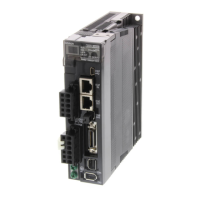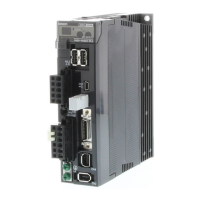12-15
12-4 Troubleshooting
OMNUC G5-series AC Servomotors and Servo Drives User’s Manual (with Built-in EtherCAT Communications)
12
Troubleshooting and Maintenance
14
0
Overcurrent The current flowing through the converter
exceeded the specified value.
• The Servo Drive is faulty (faulty circuit,
faulty IGBT part, etc.).
• The Servomotor cable is short-circuited
between phases U, V, and W.
• The Servomotor cable is ground-faulted.
• Motor windings are burned out.
• The Servomotor wiring contacts are
faulty.
• The relay for the dynamic brake has
been welded due to frequent servo ON/
OFF operations.
• The Servomotor is not suitable for the
Servo Drive.
• The pulse input timing is the same as or
earlier than the servo ON timing.
• Disconnect the Servomotor cable, and
turn ON the servo. If the problem
immediately recurs, replace the Servo
Drive with a new one.
• Check to see if the Servomotor cable is
short-circuited between phases U, V
and W by checking for loose wire
strands on the connector lead. Connect
the Servomotor cable correctly.
• Check the insulation resistance between
phases U, V, and W of the Servomotor
cable and the grounding wire of the
Servomotor. If the insulation is faulty,
replace the Servomotor.
• Check the balance between the
resistance of each wire of the
Servomotor. If resistance is unbalanced,
replace the Servomotor.
• Check for missing connector pins in
Servomotor connections U, V, and W. If
any loose or missing connector pins are
found, secure them firmly.
• Replace the Servo Drive. Do not start or
stop the system by turning the servo ON
or OFF.
• Check model (capacity) of the
Servomotor and the Servo Drive on the
nameplates. Replace the Servomotor
with a Servomotor that matches the
Servo Drive.
• Wait at least 100 ms after the servo has
been turned ON, then input pulses.
1
IPM Error
15 0
Servo Drive
Overheat
The temperature of the Servo Drive
radiator or power elements exceeded the
specified value.
• The ambient temperature of the Servo
Drive exceeded the specified value.
• Overload
• Improve the ambient temperature and
the cooling conditions of the Servo
Drive.
• Increase the capacities of the Servo
Drive and the Servomotor. Set longer
acceleration and deceleration times.
Reduce the load.
Error No. (hex)
Name Cause Measures
Main Sub

